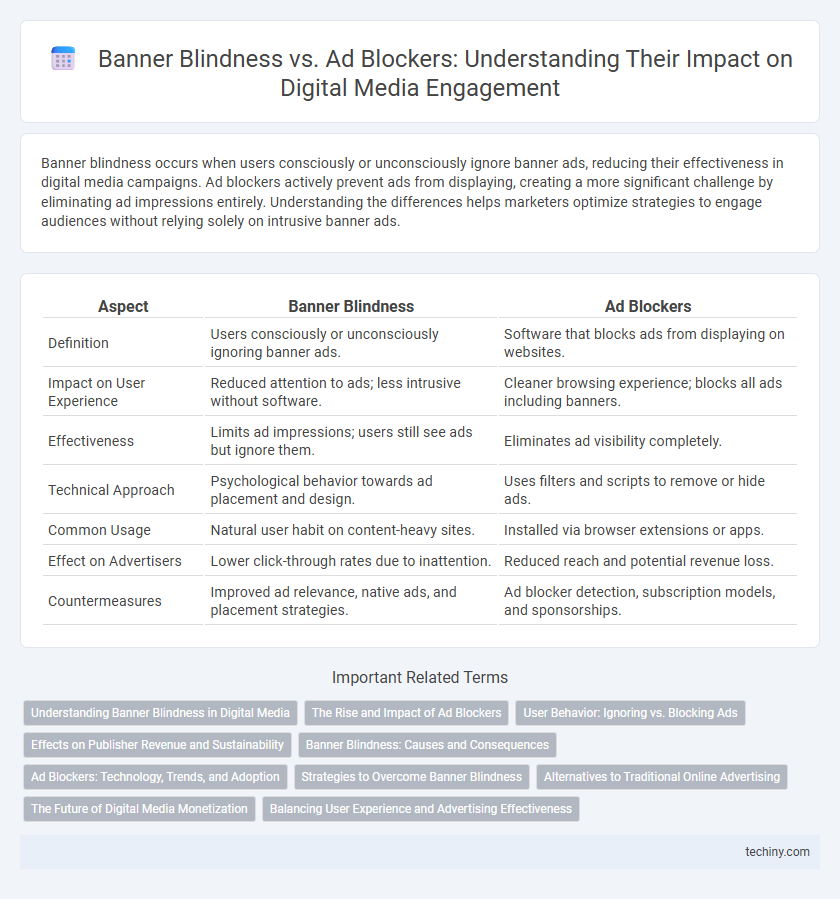Banner blindness occurs when users consciously or unconsciously ignore banner ads, reducing their effectiveness in digital media campaigns. Ad blockers actively prevent ads from displaying, creating a more significant challenge by eliminating ad impressions entirely. Understanding the differences helps marketers optimize strategies to engage audiences without relying solely on intrusive banner ads.
Table of Comparison
| Aspect | Banner Blindness | Ad Blockers |
|---|---|---|
| Definition | Users consciously or unconsciously ignoring banner ads. | Software that blocks ads from displaying on websites. |
| Impact on User Experience | Reduced attention to ads; less intrusive without software. | Cleaner browsing experience; blocks all ads including banners. |
| Effectiveness | Limits ad impressions; users still see ads but ignore them. | Eliminates ad visibility completely. |
| Technical Approach | Psychological behavior towards ad placement and design. | Uses filters and scripts to remove or hide ads. |
| Common Usage | Natural user habit on content-heavy sites. | Installed via browser extensions or apps. |
| Effect on Advertisers | Lower click-through rates due to inattention. | Reduced reach and potential revenue loss. |
| Countermeasures | Improved ad relevance, native ads, and placement strategies. | Ad blocker detection, subscription models, and sponsorships. |
Understanding Banner Blindness in Digital Media
Banner blindness occurs when users consciously or unconsciously ignore banner ads on websites, reducing their effectiveness in digital media campaigns. It stems from habitual exposure leading to selective attention, where users focus on desired content while filtering out surrounding advertisements. This behavior challenges marketers to design more engaging, native ads that seamlessly integrate with site content to capture audience attention.
The Rise and Impact of Ad Blockers
The rise of ad blockers has significantly shifted digital media strategies as users increasingly avoid intrusive advertisements, leading to a decline in banner ad visibility and effectiveness. Studies show that over 40% of internet users now employ ad blocking software, directly contributing to the phenomenon known as banner blindness where users consciously or unconsciously ignore static ad placements. This trend forces marketers to innovate with native advertising, personalized content, and integrated marketing solutions to maintain engagement and ROI in a landscape altered by ad blocker proliferation.
User Behavior: Ignoring vs. Blocking Ads
Users exhibit Banner Blindness by subconsciously ignoring digital ads, effectively diminishing ad impressions without technical intervention. In contrast, Ad Blockers actively prevent ads from loading, directly reducing ad exposure and impacting advertiser revenue. Both behaviors reflect growing user resistance to online advertising but differ in cognitive engagement and technological enforcement.
Effects on Publisher Revenue and Sustainability
Banner blindness significantly reduces user engagement with digital ads, directly impacting publisher revenue by lowering ad impressions and click-through rates. Ad blockers further exacerbate this challenge by completely preventing ads from being displayed, leading to substantial revenue losses and threatening the financial sustainability of content creators. Publishers must explore alternative monetization strategies, such as native advertising and subscription models, to maintain revenue streams amid these shifting user behaviors.
Banner Blindness: Causes and Consequences
Banner blindness occurs when users subconsciously ignore banner-like information, primarily due to repetitive exposure, lack of relevance, and intrusive ad design. This phenomenon significantly decreases click-through rates and hampers advertisers' ability to engage audiences effectively, leading to wasted ad spend and diminished campaign ROI. Understanding the psychological and behavioral triggers behind banner blindness is crucial for optimizing digital media strategies and improving ad placement efficacy.
Ad Blockers: Technology, Trends, and Adoption
Ad blockers employ advanced algorithms and machine learning to identify and filter out intrusive digital advertisements, enhancing user experience by reducing unwanted content and page load times. The adoption of ad blocking technology has surged globally, driven by increasing consumer demand for privacy, faster browsing, and reduced data consumption across desktops and mobile devices. Current trends indicate significant integration of ad blockers into browsers and mobile apps, with continuous updates to counter new advertising techniques and ensure effective blocking.
Strategies to Overcome Banner Blindness
To overcome banner blindness in digital media, advertisers must implement native advertising, seamlessly integrating promotional content with relevant site material to capture user attention without disrupting the experience. Utilizing personalized, contextually targeted ads enhances engagement by aligning with user interests and browsing behavior. Employing interactive elements such as animations and rich media further increases visibility by encouraging active user interaction and reducing the likelihood of ad avoidance.
Alternatives to Traditional Online Advertising
Banner blindness and ad blockers significantly reduce the effectiveness of traditional online advertising by causing users to ignore or block ads. Alternatives such as native advertising, influencer marketing, and content marketing offer seamless integration into user experiences, boosting engagement without disrupting browsing behavior. Leveraging personalized ads and interactive formats also helps brands capture attention and improve conversion rates in the digital media landscape.
The Future of Digital Media Monetization
Banner blindness significantly reduces the effectiveness of traditional display ads, while ad blockers further challenge revenue streams by filtering out intrusive advertisements. Emerging digital media monetization models pivot towards native advertising, content sponsorships, and subscription services to bypass these obstacles. Innovations in contextual targeting and personalized ad experiences are crucial for sustaining advertiser investment and enhancing user engagement in the evolving digital landscape.
Balancing User Experience and Advertising Effectiveness
Banner blindness reduces ad effectiveness as users subconsciously ignore page elements resembling ads, making traditional banner ads less impactful. Ad blockers enhance user experience by removing intrusive advertisements but also decrease revenue for digital publishers relying on ad impressions and clicks. Balancing user experience and advertising effectiveness requires integrating non-intrusive ad formats like native advertising and personalized content to maintain engagement without alienating users.
Banner Blindness vs Ad Blockers Infographic

 techiny.com
techiny.com